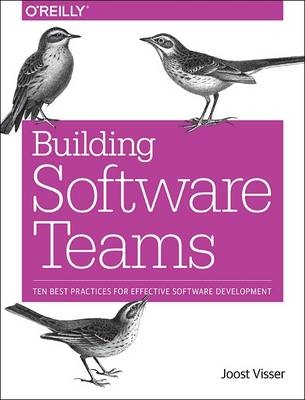
Building Software Teams
O'Reilly Media (Verlag)
978-1-4919-5177-4 (ISBN)
As a follow-up to their popular book, Building Maintainable Software, consultants with the Software Improvement Group (SIG) offer critical lessons based on their assessment of development processes used by hundreds of software teams. Each practice includes examples of goalsetting to help you choose the right metrics for your team.
- Achieve development goals by determining meaningful metrics with the Goal-Question-Metric approach
- Translate those goals to a verifiable Definition of Done
- Manage code versions for consistent and predictable modification
- Control separate environments for each stage in the development pipeline
- Automate tests as much as possible and steer their guidelines and expectations
- Let the Continuous Integration server do much of the hard work for you
- Automate the process of pushing code through the pipeline
- Define development process standards to improve consistency and simplicity
- Manage dependencies on third party code to keep your software consistent and up to date
- Document only the most necessary and current knowledge
Joost Visser is Head of Research at the Software Improvement Group (SIG). Joost also holds a position as professor of Large Scale Software Systems at Radboud University Nijmegen. He has obtained his PhD in Computer Science from the University of Amsterdam and has published over 100 papers on topics such as generic programming, program transformation, green computing, software quality, and software evolution.
Gijs Wijnholds joined the Software Improvement Group in 2015 as a software quality consultant in public administration. He helps clients get in control of their software projects by advising them on development processes and translating technical risks into strategic decisions. Gijs holds a BSc in AI from Utrecht University and a MSc degree in Logic from University of Amsterdam. Gijs Wijnholds joined the Software Improvement Group in 2015 as a software quality consultant in public administration. He helps clients get in control of their software projects by advising them on development processes and translating technical risks into strategic decisions. Gijs holds a BSc in AI from Utrecht University and a MSc degree in Logic from University of Amsterdam.
Sylvan Rigal works as a software quality consultant at SIG since 2011 and is advising clients on managing their IT since 2008. He holds a MSc in international business from Maastricht University, The Netherlands (2006). As an active member of SIG's software security team, Sylvan trains consultants on analyzing software security risks.
Chapter 1Introduction
Software Development as an Observable Process
Software Quality According to the ISO 25010 Standard
The Contribution of Each Developer Matters
Measuring and Benchmarking Development Process Maturity
The Goal-Question-Metric Approach
An Overview of the Development Best Practices in This Book
Chapter 2Derive Metrics from Your Measurement Goals
Motivation
How to Apply the Best Practice
Make Assumptions about Your Metrics Explicit
Common Objections to GQM
Chapter 3Make Definition of Done Explicit
Motivation
How to Apply the Best Practice
Common Objections to Using Definition of Done
Chapter 4Control Code Versions and Development Branches
Motivation
How to Apply the Best Practice
Controlling Versions in Practice
Common Objections to Version Control Metrics
Metrics Overview
Chapter 5Control Development, Test, Acceptance, and Production Environments
Motivation
How to Apply the Best Practice
Measuring the DTAP Street in Practice
Common Objections to DTAP Control Metrics
Metrics Overview
Chapter 6Automate Tests
Motivation
How to Apply the Best Practice
Managing Test Automation in Practice
Common Objections to Test Automation Metrics
Metrics Overview
Chapter 7Use Continuous Integration
Motivation
How to Apply the Best Practice
Controlling Continuous Integration
Common Objections to Continuous Integration Metrics
Metrics Overview
Chapter 8Automate Deployment
Motivation
How to Apply the Best Practice
Measuring the Deployment Process
Common Objections to Deployment Automation Metrics
Metrics Overview
Chapter 9Standardize the Development Environment
Motivation
How to Apply the Best Practice
Controlling Standards Using GQM
Common Objections to Standardization
Metrics Overview
Chapter 10Manage Usage of Third-Party Code
Motivation
How to Apply the Best Practice
Measuring Your Dependency Management
Common Objections to Third-Party Code Metrics
Metrics Overview
Chapter 11Document Just Enough
Motivation
How to Apply the Best Practice
Managing Your Documentation
Common Objections to Documentation
Metrics Overview
Chapter 12Next Steps
Applying the Best Practices Requires Persistence
One Practice at a Time
Avoid the Metric Pitfalls
What Is Next?
| Erscheinungsdatum | 19.01.2017 |
|---|---|
| Zusatzinfo | black & white illustrations |
| Verlagsort | Sebastopol |
| Sprache | englisch |
| Maße | 180 x 233 mm |
| Gewicht | 244 g |
| Einbandart | kartoniert |
| Themenwelt | Mathematik / Informatik ► Informatik ► Software Entwicklung |
| Wirtschaft ► Betriebswirtschaft / Management ► Personalwesen | |
| Schlagworte | Softwareentwicklung • Teambuilding • Teams führen |
| ISBN-10 | 1-4919-5177-X / 149195177X |
| ISBN-13 | 978-1-4919-5177-4 / 9781491951774 |
| Zustand | Neuware |
| Informationen gemäß Produktsicherheitsverordnung (GPSR) | |
| Haben Sie eine Frage zum Produkt? |
aus dem Bereich


